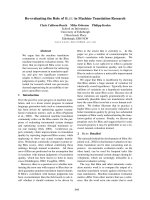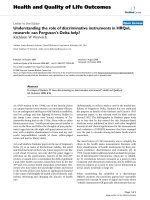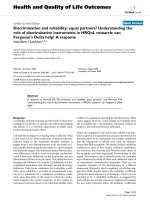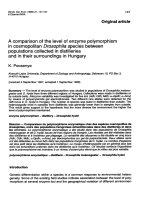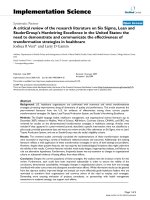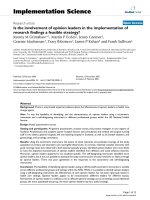The employment of reporting verbs in tesol research articles between non native and native english writers
Bạn đang xem bản rút gọn của tài liệu. Xem và tải ngay bản đầy đủ của tài liệu tại đây (2.24 MB, 93 trang )
MINISTRY OF EDUCATION AND TRAINING
HO CHI MINH CITY UNIVERSITY OF TECHNOLOGY
---------------------------
TRAN PHUONG NHI
THE EMPLOYMENT OF REPORTING VERBS IN
TESOL RESEARCH ARTICLES BETWEEN
NON-NATIVE AND NATIVE ENGLISH WRITERS
MASTER THESIS
Major: English Language
Course code: 60220201
HO CHI MINH CITY, JUNE 2020
MINISTRY OF EDUCATION AND TRAINING
HO CHI MINH CITY UNIVERSITY OF TECHNOLOGY
---------------------------
THE EMPLOYMENT OF REPORTING VERBS IN
TESOL RESEARCH ARTICLES BETWEEN
NON-NATIVE AND NATIVE ENGLISH WRITERS
Submitted to the
Faculty of English Language
in partial fulfillment of the Master‘s degree in English Language
Course code: 60220201
By
TRAN PHUONG NHI
Supervised by
DUONG MY THAM, Ph.D.
HO CHI MINH CITY, JUNE 2020
This thesis entiled: The Employment of Reporting Verbs in TESOL Research
Articles between Non-Native and Native English Writers
was successfully defended and approved on May 28, 2020
at Ho Chi Minh City University of Technology (HUTECH).
Academic Supervisor: Duong My Tham, Ph.D.
Signature:...............................................
Examination Committee
1. Nguyen Thi Kieu Thu Ph.D. ..................................... Chair
2. Cao Thi Phuong Dung Ph.D. .................................... Reader 1
3. Nguyen Thi Nhu Ngoc Ph.D. ................................... Reader 2
4. Nguyen Tien Hung Ph.D. ......................................... Member
5. Le Van Tuyen Ph.D. .................................................. Secretary Member
On behalf of the Examination Committee
Chair
...............................................................................
(full name, title, signature)
HCMC UNIVERSITY OF TECHNOLOGY
POSTGRADUATE INSTITUTE
_____________________
HCMC, December 18, 2019
MASTER’S THESIS REPORT
Student name: Tran Phuong Nhi
Sex: Female
Date of birth: June 27, 1994
Place of birth: Ho Chi Minh City
Major: English Language
Student code: 1741900062
I- Thesis title:
The Employment of Reporting Verbs in TESOL Research Articles between Non-native
and Native English Writers
II- Objectives and contents:
This thesis is aimed to examine the frequency and explore the semantic dimensions of
the reporting verbs that were used in TESOL research articles written by Non-native
and Native English writers in a form of comparison.
The thesis supports and raises the awareness of the Non-native and Vietnamese
students to use reporting verbs appropriately.
III- Starting date:
IV- Completing date: December 18, 2019
V- Academic supervisor: (full name, title) Duong My Tham Ph.D.
SUPERVISOR
DEAN OF FACULTY OF ENGLISH LANGUAGE
(full name, signature)
(full name, signature)
CERTIFICATE OF ORIGINALITY
I certify my authorship of the Master‘s Thesis submitted today entitled:
THE EMPLOYMENT OF REPORTING VERBS IN TESOL RESEARCH
ARTICLES BETWEEN NON-NATIVE AND NATIVE ENGLISH WRITERS
In terms of the statement of the requirements for Theses in Master‘s Programs issued
by Higher Degree Committee of Faculty of English Language, Ho Chi Minh City
University of Technology.
Ho Chi Minh City, December 2019
Signature: TRẦN PHƯƠNG NHI
i
RETENTION AND USE OF THE THESIS
I hereby state that I, TRAN PHUONG NHI, being a candidate for the degree of Master
of Arts (English Language) accept the requirements of the University relating to the
retention and use of Master‘s Theses deposited in the Library.
In terms of these conditions, I agree that the original of my Master‘s Thesis deposited
in the Library should be accessible for purposes of study and research, in accordance
with the normal conditions established by the Librarian for the care, loan and
reproduction for theses.
Ho Chi Minh City, December 2019
Signature: TRẦN PHƯƠNG NHI
ii
ACKNOWLEDGEMENTS
First of all, I would like to show my gratefulness to my supervisor, Dr. Duong
My Tham, for her insightful instruction, patience, encouragement, and constructive
feedback on my entire thesis.
I would like to show my gratitude to all the lecturers of English at Faculty of
English language – HUTECH University especially Dr. Nguyen Thi Kieu Thu, who
consulted and supported me to find a right way to conduct the Master thesis. I would
also like to thank Dr. Tran Quoc Thao for his guidance on writing a standard thesis.
I am indebted Board of Examiners for considering my thesis and giving me
precious advice that I can improve this thesis well.
Finally, I would like to say thank you to my family for supporting,
encouraging and giving me a lot of motivation to complete the thesis.
iii
ABSTRACT
The aims of this thesis were to research the differences in using reporting
verbs in terms of frequency and semantic dimensions between non-native and native
English writers in their TESOL research articles. The research sample was a corpus of
60 research articles which contains 30 articles written by non-native English writers,
and 30 other articles written by native English writers, adopted in the thesis. The thesis
employed mixed-methods research in which both qualitative and quantitative methods
used to analyze the corpus. AntConc Software version 3.5.7 was used in the research
to make a statistic for the frequency of each reporting verb quantitatively. Then,
semantic dimensions of reporting verbs were qualitatively analyzed by comparing
similarities and differences in four main semantic aspects of reporting verbs, namely
Affectedness, Explicitness, Speech Acts and Formality between non-native English
and native English writers.
The results showed that there were significant differences in the frequency
and semantic dimensions of reporting verbs. Specifically, the native English writers
used reporting verbs with their strong argument for the findings, while non-native
English writers used reporting verbs with the objective attitude to contribute and
support their viewpoints. Reporting verbs are very important in writing research
because this is a tool to integrate the previous works of the other authors, their words
or their ideas; therefore, this thesis could be a reference for the further researchers to
use reporting verbs proficiently in their research, and EFL teachers would instruct
students to use reporting verbs appropriately.
iv
LIST OF FIGURES
No table of figures entries found.
v
LIST OF TABLES
Table 2.1 Semantic dimensions of the field of reporting verbs .......................17
Table 3.1 Corpora description .........................................................................28
Table 3.2 Data analysis procedure ...................................................................31
Table 3.3 The research questions in relation to data analysis tools .................32
Table 4.1 Overview of the frequencies and the semantic dimensions of the four groups
of reporting verbs in the two corpora of 60 research articles ..........................34
Table 4.2 The example of Argue Group that is used by the native and non-native
English writers .................................................................................................35
Table 4.3 The example of Find Group that is used by the native and non-native English
writers ..............................................................................................................36
Table 4.4 The example of Think Group that is used by the native and non-native
English writers .................................................................................................37
Table 4.5 The example of Show Group that is used by the native and non-native
English writers .................................................................................................38
Table 4.6 Frequencies and Groups of reporting verbs adopted by the native and
non-native English writers in TESOL research articles ..................................39
Table 4.7 The frequencies and percentages of reporting verbs adopted in 60 research
articles from non-native and native English writers ........................................40
Table 4.8 The semantic dimensions of the reporting verbs in TESOL research articles
adopted by non-native English writers ............................................................42
Table 4.9 The semantic dimensions of the reporting verbs in TESOL research
articles adopted by native English writers .......................................................47
Table 4.10 The semantic dimensions of reporting verbs in TESOL research articles
adopted by non-native and native English writers ..........................................53
vi
TABLE OF CONTENTS
CERTIFICATE OF THE ORIGINALITY .................................................................. i
RETENTION AND USE OF THE THESIS ................................................................ii
ACKNOWLEDGEMENTS ........................................................................................ iii
ABSTRACT .................................................................................................................. vi
LIST OF FIGURES ....................................................................................................... v
LIST OF TABLES ........................................................................................................ vi
CHAPTER 1
INTRODUCTION............................................................................... 1
1.1 Background to the study .................................................................................... 1
1.2 Statement of the problems .................................................................................. 3
1.3 Aims and objectives of the study ....................................................................... 4
1.4 Research questions ............................................................................................. 4
1.5 Scope of the study .............................................................................................. 4
1.6 Significance of the study .................................................................................... 4
1.7 Definition of the key terms ................................................................................ 5
1.8 Organization of the Thesis ................................................................................. 6
CHAPTER 2 LITERATURE REVIEW ...................................................................... 8
2.1 Definition of reporting verbs .............................................................................. 8
2.2 Types of reporting verbs ..................................................................................... 9
2.3 Semantic dimensions of reporting verbs .......................................................... 15
2.4. Previous studies ............................................................................................... 18
2.5 Conceptual framework ..................................................................................... 24
CHAPTER 3 METHODOLOGY .............................................................................. 27
3.1 Research design ................................................................................................ 27
3.2 Sample and sampling procedures ..................................................................... 28
3.3 Data collection procedure ................................................................................ 29
3.4 Data analysis procedure ................................................................................... 30
3.5 Reliability and Validity .................................................................................... 32
3.6 Summary .......................................................................................................... 33
CHAPTER 4
RESULTS AND DISCUSSIONS ..................................................... 34
4.1 Results .............................................................................................................. 34
4.1.1 An overview of reporting verbs in a corpus 60 research articles written
by native and non-native English writers ....................................................... 34
4.1.2 Significant differences in terms of frequency of reporting verbs between
non-native and native English writers ............................................................ 38
4.1.3 The semantic dimensions of the reporting verbs adopted by non-native
and native English writers .............................................................................. 41
4.2 Discussion ........................................................................................................ 56
4.2.1. Frequencies of reporting verbs ............................................................. 56
4.2.2. Semantic dimensions ............................................................................ 58
4.3. Summary .................................................................................................. 60
CHAPTER 5
CONCLUSION AND RECOMMENDATIONS ............................ 61
5.1 Summary of the main findings of the thesis .................................................... 61
5.2 Implications of the research ............................................................................. 62
5.3 Limitations of the research ............................................................................... 63
5.4. Recommendations for the further research ..................................................... 63
5.5. Summary ......................................................................................................... 63
REFERENCES ............................................................................................................ 65
APPENDIX A: THE LIST OF SAMPLE JOURNALS IN THESIS ...................... 71
APPENDIX B: SAMPLES OF THE TESOL RESEARCH ARTICLES AND
INTERFACE OF ANTCONC SOFTWARE 3.5.7 .......................... 72
APPENDIX C: LIST OF REPORTING VERBS AND THEIR POSITIONS IN
ACADEMIC WRITING ................................................................... 73
APPENDIX D: LIST OF SURVEYED ARTICLES ................................................. 78
CHAPTER 1
INTRODUCTION
1.1 Background to the study
Writing research articles requires writers to have a certain knowledge of
the research issues, techniques, and specific writing styles. That is, the writers have
to arrange all the words and ideas carefully for the research can be written
efficiently. In some significant previous studies, the reporting verbs introduce
previous works of other authors while without acknowledging the authors as the
reporters of their results. Reporting verbs play an important role in the research
because this is a tool to integrate the previous works of other authors, their words,
or their ideas.
The reporting verb is known as one of the obvious ways for the writer to
establish the credibility of the reported works (Bloch, 2010; Hawes & Thomas
(1994); Hyland (1999, 2002a); Bloch (2010, p. 221) notes that non-native English
writers always have difficulty in choosing the reporting verbs to ―satisfy both the
syntactic requirements of their sentences and perhaps, more importantly, to express
their attitudes towards the claims‖. Manan and Noor (2014) said that the writers can
use appropriate reporting verbs to quote the statements from other research which
are persuasive and suitable to their viewpoints. This happened because the writers
who are novices may lack a full understanding of the meaning of reporting verbs, or
we can say that the semantic dimensions of reporting verbs are not received the
right attention from the inexperienced researchers. Thus, the writers have to choose
in context the suitable reporting verbs for every idea and word they collect from the
other authors to show exactly their behaviors (agree, neutral, or disagree, etc.) to
those ideas and offer the writers‘ ideas in their research articles.
Researching reporting verbs is the genre analysis, a type of research
academic writings and research articles. In this thesis, we shall find the meaning of
reporting verbs in genre analysis and their roles in the research articles.
On the one hand, the research article is ―one of the most important genres
1
that received considerable attention in genre analysis‖ (Fadi, 2017, p.2). In genre
analysis, reporting verbs are the one that draws the attention of most researchers
because it is the important components in academic writing (Manan & Noor, 2014).
Reporting verbs used in academic writing help the writers show the sources from
other authors into their works. Furthermore, the critical component of research
articles is reporting verbs. Reporting verbs help the quoted statements in the
research shall be more persuasive and truthful, and it is also the constant foundation
for the writers‘ studies. In some significant studies, reporting verbs are used for
introducing previous works without acknowledging the authors as the reporters of
their results (Nguyen Thi Thuy Loan, 2017). Reporting verbs keep an important role
in the research because this is a form of integrating the previous works of the other
authors, their words, or their ideas but do not illegally copy all their published
knowledge.
On the other hand, reporting verbs are the effective ways for the writers
to establish the reliability of the reported claims (Bloch, 2010; Hawes & Thomas
(1994); Hyland (1999, 2002a); Thompson & Ye, 1991). According to Manan and
Noor (2014), by using reporting verbs, the writers are allowed to use appropriate
words to link to the source they have found it persuading and suitable to their
viewpoint of the research issues. Bloch (2010, p. 221) notes that non-native English
students always have the difficulty in choosing the reporting verbs to ―satisfy both
the syntactic requirements of their sentences and, perhaps more importantly, to
express their attitudes towards the claims‖.
Adopting appropriate reporting verbs in citing the works of the other
authors helps writers to support their statements in the research legally and
effectively. This means the writers show their respect and give credit to the previous
studies.
2
1.2 Statement of the problems
One of the most important aspects of academic writings or research is
using reporting verbs to show the references of the other authors‘ literature
(Yeganeh & Boghayeri, 2015). The appropriate reporting verbs will make a good
effect on the citation process. Charles (2006) affirmed that the right reporting verbs
allowed the writers to show the opinions they quote from other resources. Many
researchers found that it is very important for using reporting verbs in the right
contexts and others‘ ideas we would like to quote. However, in an investigation into
using reporting verbs, Yeganeh & Boghayeri (2015) found that ―non-native students
often fail to use them appropriately in their writing‖ (p. 583). Bloch (2010) also
pointed out that non-native English writers found it difficult to use reporting verbs.
Manan and Noor (2014) also assumed that the novice or non-native English writers
do not have enough attention to using the reporting verbs accurately.
How to use reporting verbs appropriately is very critical but it is likely to
be underestimated in research, although, in reality, reporting verbs are one of the
most important grammatical items in writing statements for academic writing
(Hyland, 1998). Non-native English writers may not consider about which reporting
verbs are most suitable for the particular statements in their study (Manan and Noor,
2014). Some researches show that the writers use the same reporting verbs
repeatedly in their research and choose freely any reporting verbs that do not have
any relation to the impact of the reporting verbs used (Bloch 2010).
Thus, this thesis aims to identify the reporting verbs by their semantic
dimensions in the research articles written by non-native and native English writers
and research how non-native and native English writers employed the reporting
verbs in their articles. Then there is a comparison between them in using reporting
verbs, from which we can help non-native students to improve their academic
writing. Good understanding of using reporting verbs will help the writers cite the
other authors‘ words and ideas into their studies appropriately and effectively and
present their studies more persuasively (White, 2004).
3
1.3 Aims and objectives of the study
This study aimed to examine the frequency of reporting verbs and
explore their semantic dimensions that were used in the TESOL research articles
written by non-native and native English authors in a form of comparison of how
these two groups have employed reporting verbs in their studies.
1.4 Research questions
The main two questions addressed in this thesis were:
1. What are the differences in terms of frequency of reporting verbs in
TESOL research articles written by non-native and native English authors?
2. What are the semantic dimensions of the reporting verbs employed in
the above-mentioned TESOL research articles?
1.5 Scope of the study
This study adopted sixty (60) articles in the field of TESOL that have
been published on international journals (30 articles from non-native writers and 30
articles from native English writers). This thesis only researches the frequency and
the semantic dimensions of the reporting verbs used in these corpora.
1.6 Significance of the study
Manan and Noor (2014) found that English academic writing asks the
non-native English writers should be very excellent in writing to deal with the
challenges in this field. Thus, the research articles need to be supported by the other
scholars' ideas similar to the research issues. In this case, reporting verbs are to
report these ideas and claims, also show the writers‘ attitudes towards those ideas.
From this point of view, we can see reporting verbs play an important role in
academic research articles.
Theoretically, the thesis might make a contribution to the field of TESOL
that offers some insights into the semantic dimensions of reporting verbs adopted in
4
these academic articles. According to the researcher‘s examination, there have been
few studies on reporting verbs and their semantic dimensions in TESOL research
articles in Vietnam. Reporting verbs were adopted to research in this study to
evaluate its value in the research articles and the way non-native and native English
writers use them, from which we can find how to use the reporting verbs
appropriately in each situation. Hence, the study of reporting verbs in TESOL
research articles will help readers to see insights into the use of reporting verbs in
academic research articles.
Practically, this thesis may benefit non-native English students,
especially Vietnamese EFL students and novice researchers. That is, the findings to
some extent help them know how to use reporting verbs precisely in their theses or
research in the future. Besides, this study would like to be a reference for EFL
teachers who give instructions on how to use reporting verbs in research articles
according to the standard framework.
1.7 Definition of the key terms
Citation is re-writing the others‘ works in the studies with the sources.
Corpus refers to 60 academic research articles in the field of TESOL
with 30 articles from non-native English writers (the writers who come from Iran,
Persia, Thailand, Vietnam, India, Turkey, China, Indonesia, Somalia, Brazil,
Bangladesh, Singapore, Libya, Israel) and the other 30 articles were written by
native English writers (who come from Australia, United Kingdom, United States of
America).
Native English writers are the writers who come from countries (e.g.
America, Australia, Canada, Britain, and New Zealand), where English language is
spoken as a native language.
Non-native English writers are the writers in the countries where
English is not used as the main language including the writers who come from Iran,
Persia, Thailand, Vietnam, India, Turkey, China, Indonesia, Somalia, Brazil,
5
Bangladesh, Singapore, Libya, and Israel.
Reporting verb is a verb (e.g. say, tell, believe, reply, respond, or ask)
which is used to indicate that discourse is being quoted or paraphrased.
Semantic dimensions in this thesis include Affectedness, Speech Act,
Formality and Explicitness of the reporting verbs used in 60 research articles.
TESOL means Teaching English to Speakers of Other Languages
TESOL research articles are studies conducted on teaching
methodologies.
1.8 Organization of the Thesis
This thesis comprises five separate chapters
Chapter 1 - Introduction - provides an introduction to the thesis of the
overview of reporting verbs are used in the TESOL research articles, indicates the
reason to choose the reporting verbs topic in the ‗background to the study‘ part,
state the problems that lead to conduct this thesis, provides the importance of
reporting verbs and the way to use them in the academic research precisely. Scope
of the study indicates that the TESOL field is adopted to conduct the study and
following is the definition of some important keywords.
In Chapter 2 - Literature Review - the researcher reviews some of the
significant studies in the field of reporting verbs. The definition of the reporting
verbs provided by some famous scholars in academic researches. Then the
categorized types of reporting verbs and the semantic dimensions of reporting verbs
are discussed. Previous studies present some major researches from a lot of authors
who are professional in researching this topic. The conceptual framework gives an
overview of researching frequency and semantic dimensions of reporting verbs.
Chapter 3 – Methodology - includes the research designs part shows the
research methods applied in this thesis, sample and sampling procedures part
indicates how the researchers collected the corpus and the size of the corpus.
Moreover, in this chapter, the data collection and the data analysis procedures is
6
described in detail. Then the reliability and validity part is presented to make sure
the research results are valid and reliable.
Chapter 4 – Results and Discussion - focuses on analyzing the corpus to
find the most frequent reporting verbs are used in the TESOL research articles
written by non-native and native English writers, and the semantic dimensions of
each reporting verbs are used
Chapter 5 – Conclusion and Recommendations - shows the main
findings and conclusions of this study in relation to research questions and the
limitations and recommendations for further research.
7
CHAPTER 2
LITERATURE REVIEW
There are four main parts in Chapter 2 - Literature Review. The first one
is the definition of reporting verbs which defines what the reporting verbs are and
their roles in academic writing and research. The second part presents types of
reporting verbs. Third part is semantic dimensions of reporting verbs addressing
original utterance, specification of attitudes toward the complement clause, and
strength of the complement. Lastly, previous studies are presented, and conceptual
framework gives an overview of the main points of Chapter 2.
2.1 Definition of reporting verbs
Charles (2006) defines the reporting verbs as a tool ―to give credit to
other researchers to use their work in the cumulative construction of knowledge‖
(p.326) while Hyland (1999) and Thompson and Ye (1991) argue that reporting
verbs which show writers‘ behavior to the other researchers‘ works are very
important linguistic features. Also, Hyland (2005) defines reporting verbs as a
lexical device to help the writers to state their viewpoints and connect with the
readers. These definitions support each other, thus give us insightful understanding
of reporting verbs used in the research articles.
In academic writing, reporting verbs, also known as introductory verbs,
are used is to acknowledge and reveal the source of previous researches. The
investigation of Thompson and Ye (1991) has shown that reporting verbs help the
writers show their attitude and evaluation on the statements of the other works. In
Swales and Feak study (2004, p.164), it also shows that the reporting verbs ―reveals
your personal stance toward the source material‖. On the other hand, reporting
verbs play a role to show the writers‘ feelings. The present findings seem to be
consistent with other research which found the reporting verbs are the grammatical
device for the writers can use to have an effect for their academic researches
(Hyland, 1998). Hyland (1999, 2002) found that reporting verbs can be adopted to
report their statements and ideas, also demonstrate their feelings and attitude
8
towards the others‘ statements (Hyland, 2002).
To sum up, reporting verbs, are verbs used when scholars report or
mention other writers‘ statements and ideas that the researchers agree with. Using
the reporting verbs in their written study can help reflect their attitude toward
information that originates or helps scholars speak their opinion or reasoning better
in public assigned. This definition and discussion are great to mention about
reporting verbs. Therefore, the author take this concept for the study.
2.2 Types of reporting verbs
2.2.1 Overview of the popular frameworks
Reporting verbs used in most of the studies are categorized based on the
common frameworks of Thompson and Ye (1991) or Hyland (1999). Thompson and
Ye (1991) conducted the first research on categorizing reporting verbs of their
semantic differences divided reporting verbs into three groups: Textual verbs,
Mental verbs and Research verbs. Thompson and Ye (1991) showed a statement that
―Textual verbs are those that have an obligatory component of verbal expression‖
such as state, indicate - the stance of the writer, while Mental verbs show us the
thoughts of the author such as believe, think - the stance of the author whose claims
are being reported. The third group is Research verbs which describe the research
activity or experimental procedures, for example, like find, explore - the
interpretation of the writer.
Hyland (1999) identifies three types of reporting verbs based on
Thompson and Ye (1991); however, he uses the terms Discourse and Cognition
instead of Textual and Mental, respectively. Hyland still uses the word Research
verb for the reporting verbs group which mention about the research activities or
experimental procedures, for example: find, demonstrate.
In the Research Acts group, there are: factive verbs to show their
acceptance of the author‘s results or conclusions (Nguyen Thi Thuy Loan &
Pramoolsook, 2015), counter-factive verbs are to show that the writers do not accept
9
the viewpoint of the other authors, and the last one is non-factive, which used to
make remarks of the previous research used in their articles.
The reporting verbs in the Cognitive Acts described the studies which
were cited of mental process (Hyland, 2002), and the last group is Discourse Acts
that show the writers‘ point of view, which were aimed to evaluate the cited works
by either ―taking responsibility for his or her interpretation by conveying their
uncertainty or assurance of the correctness of the claims reported or attributing a
qualification to the author‖ (Nguyen Thi Thuy Loan, 2017, p.38), divided into
Doubt, includes Tentative verbs, such as suggest, indicate; and Critical verbs such
as exaggerate - not make point), Assurance to inform the author‘s position
(non-factive) and ―support the writer‘s own view‖, and Counters for the writers to
give the ―objections or reservations‖ to the author‘s ideas.
In addition, Hyland (2002) has a detailed explanation for each verb group.
Reporting verbs of Cognition Acts show the cited works in terms of mental process.
The writers do not need to take explicit stance on the statements which are reported.
They could attribute their own attitude to the cited statements from the other‘s
works. In his research, Hyland (2002) offer four options for the writers to express
their thoughts of the reported proposition.
In the first option, the reporting verbs show the positive attitude and/or
accept the reported statements in the studies: know, think, agree, hold, concur and
understand. The second option expresses the tentative attitude to the ideas or
statements from the other works such as doubt, believe, suppose, suspect and
speculate. The third option of reporting verbs in Cognition Acts shows the critical
comments with the negative attitude with the cited ideas: disagree, dispute, not
think, etc. Finally, the last group shows the writers' neutral attitude towards the
opinions from the other authors such as picture, conceive, anticipate, reflect and
state. In the case of this study, reporting verbs employed are the attitude towards
claim type, as Lewin (2005, p.173) said: ―a reflection of truth‖.
10
Figure 2.1: Categories of Reporting Verbs (Hyland, 2002, p. 119)
Figure 2.1 shows the study of Hyland in 2002 categorized the reporting
verbs. There are three main categories: Research Acts, Cognition Acts and
Discourse Acts verbs. The Research Acts category includes the reporting verbs are
used in Findings type and Procedures type, in Findings: Factive verbs are to show
the acceptance of the cited works, Counter-factive verbs are to judge the incorrect
or wrong statements and Non-factive adopted to comment the research findings.
Cognition Acts category includes four types: Positive, Critical, Tentative, Neutral.
These all types used to express the authors‘ attitudes and feelings with the others‘
works in the research. The third category Discourse Acts contains Doubt, Assurance,
and Counters. Doubt type includes Tentative - to give the question, assumption or
suggest and Critical - means not make the point. Assurance to inform the author‘s
position and support the writer‘s view, and Counters for the writers to give the
objections or reservations to the author‘s ideas
Furthermore, a framework of categorizing the reporting verbs which is
different from all the frameworks are mentioned above, is the theoretical framework
of Francis, Hunston & Manning‘s (1996) classification of reporting verbs. The
findings showed that both Persian and English speakers use the Argue group of
reporting verbs most frequently, as compared to the other groups of reporting verbs.
The results also indicated that while native English writers show a tendency toward
Think verbs as their second priority, the native Persian writers are more oriented
towards the use of Find verbs as their second priority.
11
Argue verbs are used most in communication and even in writing.
Example: suggest, point out and indicate.
Think verbs are used to show the writer‘s thoughts, feelings, and beliefs
Example: think, assume and believe
Show verbs are to indicate a situation or a fact in research cases.
Example: ―show, demonstrate and reveal‖ (Francis et al., 1996)
Find verbs describes what the writers find in research or what they think.
Example: find, discover, establish
These findings suggest that in general three frameworks above have
given us a clear overview of the way reporting verbs are categorized. Although the
frameworks of Hyland and Thompson and Ye are adopted commonly in most of
research in the world, this thesis adopt the framework from Francis, Huston and
Manning (1996) to categorize the reporting verbs because of its high relation to the
semantic dimensions which will be analyzed in this thesis. The researchers used the
reporting verbs classification of Francis, Hunston & Manning (1996) as a
theoretical framework.
Figure 2.2:Verb “that clause” pattern (Francis, Hunston, & Manning 1996)
In Figure 2.1, Verb That-Clause Pattern is named reporting verbs, and
there are four kinds of reporting verbs group: ARGUE group, THINK group and
SHOW / FIND group. The SHOW and FIND groups are placed in the same place;
perhaps the authors who built this figure considered the meanings of these two
groups are to indicate the results or findings from the research process. However, in
this study, the researcher splits this into two groups for analyzing the reporting
12
verbs in more details and precisely as Francis, Hunston and Manning (1996). The
classification of Francis, Hunston and Manning (1996) indicates a verb from that
clause, whereby the verbs are classified into four groups including ARGUE group,
THINK group, SHOW group and FIND group.
In academic writings, it is necessary to refer to other people‘s studies by
using the reporting verbs. Reporting verbs help readers understand the relevance of
the sources in the writings and can help scholars reinforce their arguments.
Figure 2.3: Degree of strength in use of reporting verbs (Sources: RMIT
University Study and Learning Center (2012))
13
